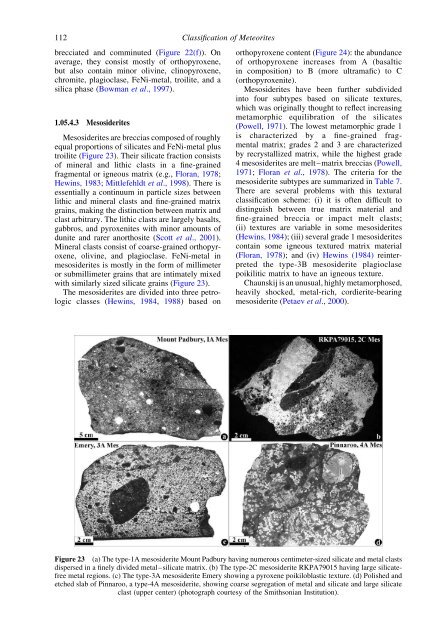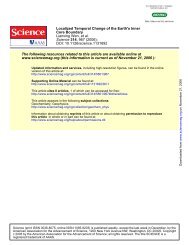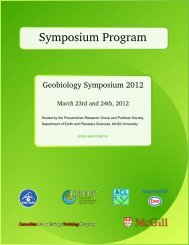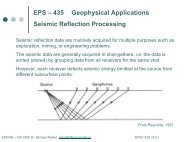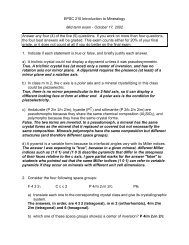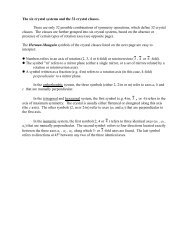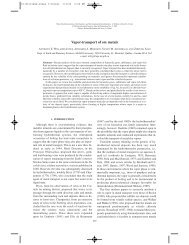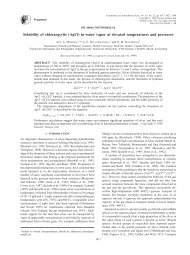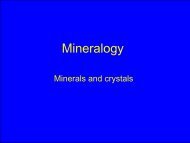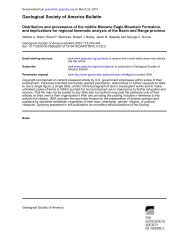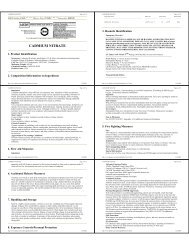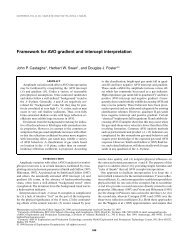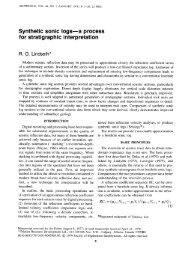05 Classification of.. - Department of Earth and Planetary Sciences
05 Classification of.. - Department of Earth and Planetary Sciences
05 Classification of.. - Department of Earth and Planetary Sciences
You also want an ePaper? Increase the reach of your titles
YUMPU automatically turns print PDFs into web optimized ePapers that Google loves.
112<br />
brecciated <strong>and</strong> comminuted (Figure 22(f)). On<br />
average, they consist mostly <strong>of</strong> orthopyroxene,<br />
but also contain minor olivine, clinopyroxene,<br />
chromite, plagioclase, FeNi-metal, troilite, <strong>and</strong> a<br />
silica phase (Bowman et al., 1997).<br />
1.<strong>05</strong>.4.3 Mesosiderites<br />
Mesosiderites are breccias composed <strong>of</strong> roughly<br />
equal proportions <strong>of</strong> silicates <strong>and</strong> FeNi-metal plus<br />
troilite (Figure 23). Their silicate fraction consists<br />
<strong>of</strong> mineral <strong>and</strong> lithic clasts in a fine-grained<br />
fragmental or igneous matrix (e.g., Floran, 1978;<br />
Hewins, 1983; Mittlefehldt et al., 1998). There is<br />
essentially a continuum in particle sizes between<br />
lithic <strong>and</strong> mineral clasts <strong>and</strong> fine-grained matrix<br />
grains, making the distinction between matrix <strong>and</strong><br />
clast arbitrary. The lithic clasts are largely basalts,<br />
gabbros, <strong>and</strong> pyroxenites with minor amounts <strong>of</strong><br />
dunite <strong>and</strong> rarer anorthosite (Scott et al., 2001).<br />
Mineral clasts consist <strong>of</strong> coarse-grained orthopyroxene,<br />
olivine, <strong>and</strong> plagioclase. FeNi-metal in<br />
mesosiderites is mostly in the form <strong>of</strong> millimeter<br />
or submillimeter grains that are intimately mixed<br />
with similarly sized silicate grains (Figure 23).<br />
The mesosiderites are divided into three petrologic<br />
classes (Hewins, 1984, 1988) based on<br />
<strong>Classification</strong> <strong>of</strong> Meteorites<br />
orthopyroxene content (Figure 24): the abundance<br />
<strong>of</strong> orthopyroxene increases from A (basaltic<br />
in composition) to B (more ultramafic) to C<br />
(orthopyroxenite).<br />
Mesosiderites have been further subdivided<br />
into four subtypes based on silicate textures,<br />
which was originally thought to reflect increasing<br />
metamorphic equilibration <strong>of</strong> the silicates<br />
(Powell, 1971). The lowest metamorphic grade 1<br />
is characterized by a fine-grained fragmental<br />
matrix; grades 2 <strong>and</strong> 3 are characterized<br />
by recrystallized matrix, while the highest grade<br />
4 mesosiderites are melt–matrix breccias (Powell,<br />
1971; Floran et al., 1978). The criteria for the<br />
mesosiderite subtypes are summarized in Table 7.<br />
There are several problems with this textural<br />
classification scheme: (i) it is <strong>of</strong>ten difficult to<br />
distinguish between true matrix material <strong>and</strong><br />
fine-grained breccia or impact melt clasts;<br />
(ii) textures are variable in some mesosiderites<br />
(Hewins, 1984); (iii) several grade 1 mesosiderites<br />
contain some igneous textured matrix material<br />
(Floran, 1978); <strong>and</strong> (iv) Hewins (1984) reinterpreted<br />
the type-3B mesosiderite plagioclase<br />
poikilitic matrix to have an igneous texture.<br />
Chaunskij is an unusual, highly metamorphosed,<br />
heavily shocked, metal-rich, cordierite-bearing<br />
mesosiderite (Petaev et al., 2000).<br />
Figure 23 (a) The type-1A mesosiderite Mount Padbury having numerous centimeter-sized silicate <strong>and</strong> metal clasts<br />
dispersed in a finely divided metal–silicate matrix. (b) The type-2C mesosiderite RKPA79015 having large silicatefree<br />
metal regions. (c) The type-3A mesosiderite Emery showing a pyroxene poikiloblastic texture. (d) Polished <strong>and</strong><br />
etched slab <strong>of</strong> Pinnaroo, a type-4A mesosiderite, showing coarse segregation <strong>of</strong> metal <strong>and</strong> silicate <strong>and</strong> large silicate<br />
clast (upper center) (photograph courtesy <strong>of</strong> the Smithsonian Institution).


